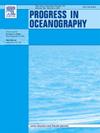Phytoplankton growth driven by submesoscale processes under convective turbulence: Lagrangian plankton model results
IF 3.6
3区 地球科学
Q1 OCEANOGRAPHY
引用次数: 0
Abstract
Submesoscale turbulence influences phytoplankton growth by enhancing upper-ocean stratification, nutrient entrainment, and horizontal tracer variability. However, the specific mechanisms and their relative contributions under convective forcing remain unclear. Here, we use large-eddy simulations coupled with a Lagrangian plankton model to quantify the physical and biological impacts of submesoscale turbulence across varying cooling intensities and nutrient levels, comparing cases with and without submesoscale turbulence. Under weak cooling with low nutrients, submesoscale turbulence enhances nutrient entrainment but initially suppresses growth by subducting phytoplankton into deeper, light-limited waters. As restratification progresses, greater surface retention yields net growth enhancement alongside higher nutrient supply. Conversely, when nutrients are abundant, submesoscale turbulence enhances light exposure and promotes growth. Under strong cooling conditions, convective mixing dominates, homogenizing tracers and diminishing submesoscale influence. Nonethelss, weak restratification from submesoscale turbulence still yields small gains in light exposure and growth. Additionally, horizontal heterogeneity suppresses growth when cooling is weak and nutrients are low, but is negligible otherwise. These findings highlight the need to represent interacting physical processes in ocean models. Simplified parameterizations that omit these interactions may misrepresent biological responses, especially under weak cooling.对流湍流下亚中尺度过程驱动的浮游植物生长:拉格朗日浮游生物模式结果
亚中尺度湍流通过增强上层海洋分层、营养物夹带和水平示踪变率来影响浮游植物的生长。然而,具体机制及其在对流强迫下的相对贡献仍不清楚。在这里,我们使用大涡模拟和拉格朗日浮游生物模型来量化亚中尺度湍流在不同冷却强度和营养水平下的物理和生物影响,并比较有和没有亚中尺度湍流的情况。在低营养物质的弱冷却条件下,亚中尺度湍流增强了营养物质的携带,但最初通过将浮游植物俯冲到更深的、光照受限的水域来抑制生长。随着再酸化的进行,更大的表面保留产生净生长增强和更高的营养供应。相反,当营养丰富时,亚中尺度湍流增加光照,促进生长。在强冷却条件下,对流混合占主导地位,使示踪剂均匀化,亚中尺度影响减弱。尽管如此,来自亚中尺度湍流的微弱再气化仍然会在光照和生长方面产生小的增益。此外,水平异质性在冷却弱和营养低时抑制生长,但在其他情况下可以忽略不计。这些发现强调了在海洋模式中表现相互作用的物理过程的必要性。忽略这些相互作用的简化参数化可能会歪曲生物反应,特别是在弱冷却条件下。
本文章由计算机程序翻译,如有差异,请以英文原文为准。
求助全文
约1分钟内获得全文
求助全文
来源期刊

Progress in Oceanography
地学-海洋学
CiteScore
7.20
自引率
4.90%
发文量
138
审稿时长
3 months
期刊介绍:
Progress in Oceanography publishes the longer, more comprehensive papers that most oceanographers feel are necessary, on occasion, to do justice to their work. Contributions are generally either a review of an aspect of oceanography or a treatise on an expanding oceanographic subject. The articles cover the entire spectrum of disciplines within the science of oceanography. Occasionally volumes are devoted to collections of papers and conference proceedings of exceptional interest. Essential reading for all oceanographers.
 求助内容:
求助内容: 应助结果提醒方式:
应助结果提醒方式:


